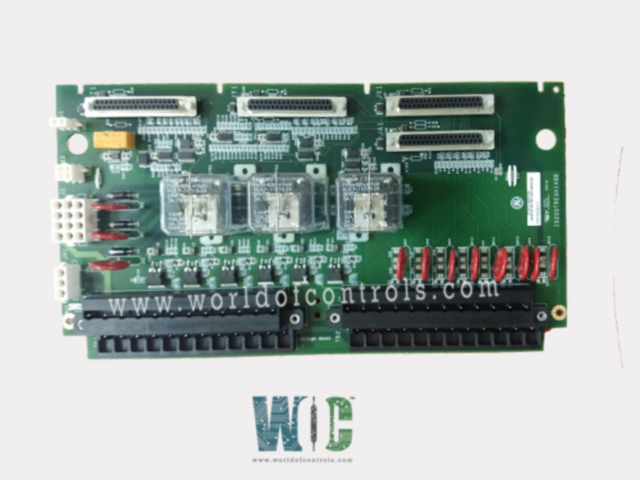
World Of Controls understands the criticality of your requirement and works towards reducing the lead time as much as possible.
IS200TRESH1A - Small Steam Turbine Emergency Trip Board is available in stock which ships the same day.
IS200TRESH1A - Small Steam Turbine Emergency Trip Board comes in UNUSED as well as REBUILT condition.
To avail our best deals for IS200TRESH1A - Small Steam Turbine Emergency Trip Board, contact us and we will get back to you within 24 hours.
SPECIFICATIONS:
Part No: IS200TRESH1A
Manufacturer: General Electric
Product Type: Small Steam Turbine Emergency Trip Board
Trip Solenoid Rating: 125 V DC
Trip Solenoid Circuits: Circuits rated For NEMA
Solenoid Response Time: Solenoid L/R Time constant is 0.1 sec
Series: Mark VI
Input Channels: 18
Output impedance: 40 Ω
Operating temperature: -30 to 65oC
Power Supply Voltage: 24 V dc
Board Size: 14.3 cm high x 23.1 cm
Weight: 0.45 kg
Availability: In Stock
Country of Origin: USA
Manual: GEH-6721D
FUNCTIONAL DESCRIPTION:
IS200TRESH1A is a Small Steam Turbine Emergency Trip Board manufactured and designed by General Electric as part of the Mark VI Series used in GE Speedtronic Control Systems. TRES is used for emergency overspeed protection for small/medium size steam turbines. TRES is controlled by the I/O controller and provides power to three emergency trip solenoids, which can be connected between the TRES and TRPS terminal boards. TRES provides the positive side of the 125 V dc to the solenoids and TRPS provides the negative side. The I/O controller provides emergency overspeed protection, and emergency stop functions, and controls the three relays on TRES, which control the three trip solenoids.
In the TRES, the seven dry contact inputs excitation, and signal are monitored and fanned to the I/O controller. The board includes the synch check relay driver, K25A, and associated monitoring, the same as on TREG, and the servo clamp relay driver, K4CL, and its associated monitoring. A second TRES board cannot be driven from the I/O controller through J4.
INSTALLATION:
The three trip solenoids are wired to the first I/O terminal block. Up to seven trip interlocks are wired to the second terminal block. The wiring connections are shown in the following figure. Connector J2 carries three power buses from TRPS, and JH1 carries the excitation voltage for the seven-trip interlocks.
OPERATION:
The I/O controller controls TRES. In simplex systems, a third cable carries a trip signal from J1 to the TSVO terminal board, providing a servo valve clamp function upon turbine trip.
CONTROL OF TRIP SOLENOIDS:
Both TREL and TRES control the trip solenoids 1 and 2 so that either one can remove the power and actuate the hydraulics to close the steam or fuel valves. ETR3 is set up to supply power to trip solenoid #3. The nine trip relay coils on TRES are supplied with 28 V DC from the I/O controller. The trip solenoids are supplied with 125 V dc (or 24 V dc) through plug J2 and draw up to 1 A with a 0.1 second L/R time constant.
SOLENOID TRIP TESTS:
Application software in the controller is used to initiate tests of the trip solenoids. Online tests allow each of the trip solenoids to be manually tripped one at a time, either through the PTR relays from the controller, or through the ETR relays from the protection module. A contact from each solenoid circuit is wired back as a contact input to give a positive indication that the solenoid has tripped. Primary and emergency offline overspeed tests are provided too for verification of actual trips due to software-simulated trip overspeed conditions.
WOC has the largest stock of OEM replacement parts for GE Speedtronic Control Systems. We can also repair your faulty boards and supply unused and rebuilt boards backed up with a warranty. Our team of experts is available round the clock to support your OEM needs. Our team of experts at WOC is happy to assist you with any of your automation requirements. For pricing and availability on parts and repairs, kindly contact our team by phone or email.
What is an emergency trip board in a small steam turbine?
An emergency trip board is a critical safety device designed to shut down the turbine quickly in case of abnormal operating conditions. It helps protect the turbine from damage and ensures the safety of the personnel and equipment.
How does the emergency trip mechanism work?
The emergency trip mechanism is activated by signals from various sensors that monitor turbine parameters such as speed, temperature, and vibration. When these parameters exceed safe limits, the trip board triggers the shutdown process, which typically involves closing the steam inlet valves to stop the turbine.
What is the difference between a trip and a normal shutdown?
A trip is an immediate and automatic shutdown triggered by the emergency trip board due to abnormal conditions, whereas a normal shutdown is a controlled and planned process performed manually or by the turbine's control system under normal operating conditions.